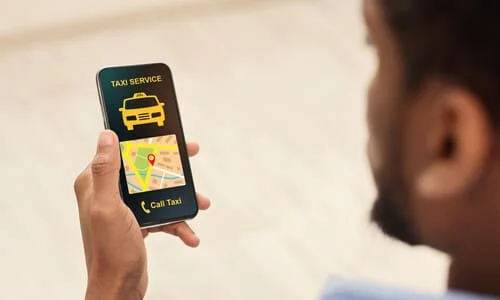 If you have been involved in a rideshare accident, you can sue for damages if the rideshare driver or another party was at-fault for the collision.
If you have been involved in a rideshare accident, you can sue for damages if the rideshare driver or another party was at-fault for the collision.
Whether you can succeed ultimately depends on the circumstances of the accident and the laws in your specific county, but in California, rideshare companies are required to provide insurance coverage for their drivers.
The rideshare driver’s required insurance typically includes liability coverage for bodily injury plus any property damage.
If the driver is found to be at fault for the accident, the rideshare company’s insurance may also provide additional coverage beyond the driver’s personal injury policy, provided they are actively using the app for the service in question.
If you’ve been injured in a rideshare accident, be sure to seek medical attention immediately. After consulting with your doctor, if you believe it is in your best interest to pursue legal action, so be sure to contact a qualified attorney.
Rideshare companies like Uber and Lyft have an arsenal of intimidating tactics that can help them avoid taking full liability in these kinds of situations, but the right attorney will be able to tap plenty of legal guardrails at the state and federal level to ensure you are protected.
So if you’re looking for confident representation, turn to Singh Ahluwalia Attorneys at Law. Our California rideshare accident lawyers can help you tackle this difficult time.
We provide confidential, no-obligation case reviews to discuss all your options. All you have to do is call (559) 878-4958 or contact us online to schedule your appointment today.
Can a Rideshare Passenger in a Car Accident Sue?
If you were a passenger in a rideshare vehicle at the time of the accident, you may be able to sue for damages. As a passenger, you have a right to a safe ride, and if you are injured due to the negligence of the rideshare driver, you may have a legal claim for compensation.
If you were injured in the accident, the first step is to seek medical attention for your injuries right away. Even if your injuries seem minor, it’s important to get a full medical evaluation to ensure there are no underlying health issues to watch out for.
Next, you should report the accident to the rideshare company. Both Uber and Lyft have insurance policies that provide coverage for their passengers, and reporting the accident to the company will help ensure that your claim is properly processed.
How Do I Report an Accident to Uber?
Here are the steps to follow to report an accident to Uber:
- Safety first: If you or anyone else involved in the accident requires immediate medical attention, call 911 or your local emergency services right away.
- Use the Uber app: Open the Uber app on your mobile device and tap the three horizontal lines in the top left corner. Then, tap “Your Trips” and select the trip that was involved in the accident.
- Tap “I was in an accident”: Scroll down to the bottom of the trip details screen and tap “I was in an accident.” This will take you to the “Report an Accident” screen.
- Follow the prompts: Follow the prompts on the screen to provide information about the accident, such as the date, time, and location of the accident, as well as any other parties involved and any injuries sustained.
- Submit the report: After you have provided all the necessary information, tap “Submit” to submit the accident report to Uber.
- Follow-up: After you have reported the accident, Uber will follow up with you to gather any additional information or to provide further instructions. Be sure to follow up promptly and provide any additional information as requested.
Note that the app’s interface may change at any time, so refer to the company website if you are unable to locate the feature that allows you to report an accident.
How Do I Report an Accident to Lyft?
Here are the steps to follow to report an accident to Lyft:
- Safety first: As with any accident, if you or anyone else involved in the accident requires immediate medical attention, make sure to call 911 or your local emergency services immediately.
- Use the Lyft app: Open the Lyft app on your mobile device and tap the menu icon (three horizontal lines) in the top left corner. Then, tap “Ride history” and select the ride that was involved in the accident.
- Tap “Get help”: Scroll down to the bottom of the ride details screen and tap “Get help.”
- Select “Accident”: Tap “Accident” from the list of options.
From there, the instructions are the same as those listed above for Uber. Simply follow the prompts to log all the necessary information, then submit your report.
After submitting the report, a Lyft representative will follow up to gather any other information they need to properly log the accident.
Again, user interfaces are subject to change, but the steps above should reflect the general process needed to report an accident.
After Reporting the Accident, Do I Sue the Driver or the Rideshare Company?
If you are involved in an accident while riding in a rideshare vehicle, you may be able to sue the rideshare company, the driver, or both for damages, depending on the circumstances of the accident.
In any situation, who you sue will depend on who can legally be found to be at fault. In an accident, often, the easiest way to pinpoint fault is to determine whose ‘negligence’ led to the accident.
Negligence as a legal concept can be defined as ‘the failure to exercise reasonable care or caution in a given situation, resulting in harm or injury to another person.’
Here are some factors that may influence who you should sue:
- The driver’s negligence: If the accident was caused by the rideshare driver’s negligence, such as running a red light or driving under the influence of drugs or alcohol, you may be able to sue both the driver and the rideshare company for damages.
- The rideshare company’s negligence: If the accident was caused by the rideshare company’s negligence, such as failing to properly screen the driver or failing to ensure they properly maintained their vehicle, you may be able to sue the rideshare company for damages.
- Insurance coverage: Rideshare companies typically provide insurance coverage for accidents that occur during a ride. Depending on the circumstances of the accident, you may need to file a claim with the driver’s personal insurance company, the rideshare company’s insurance company, or both.
It’s important to contact a skilled attorney after your accident because they can help you parse who you should hold at fault and how to do so.
If you’re still on the fence about whether you should sue the driver, rideshare company, or a third party after your car accident in Fresno our throughout California, contact our team today to discuss your options.
What Coverage Do Rideshare Companies Provide for Accidents and Injuries?
Uber and Lyft both provide rideshare insurance to cover their drivers while they’re working (i.e., logged into the app). The total amount of coverage the driver is provided will depend on their current status as a driver.
For example, when an Uber driver is logged into the app and waiting for a ride request, Uber will supplement the driver’s existing policy to ensure they have at least the following available in coverage:
- $50,000 in bodily injury per person
- $100,000 in bodily injury per accident
- $25,000 in property damage per accident
Then, for both Uber and Lyft, whenever the driver is actually en route to pick up a passenger or actively carrying passengers in their vehicle, the companies will provide up to $1,000,000 in excess liability coverage.
Of course, this will only be made available if the driver has their own state-mandated coverage, and these rideshare companies can viciously ‘reinterpret’ their own claim to coverage after an accident. That’s why it’s always best to take them on with strong legal representation.
Can I Still Sue the Driver in a Rideshare Accident if Uber or Lyft Refuses to Cover Them?
Yes, you can still sue the driver in a rideshare accident or file a claim against their personal insurance policy even if Uber or Lyft refuses to cover them.
In most cases, the driver’s personal auto insurance policy will provide coverage for accidents that occur while the driver is not working for a rideshare company.
However, if the driver was logged into the rideshare app and waiting for a passenger or transporting a passenger at the time of the accident, the driver’s personal insurance policy may not provide adequate coverage.
If Uber or Lyft refuses to cover the driver, you can still pursue a claim against the driver’s personal insurance policy, if applicable. If the driver does not have insurance or if their policy does not provide adequate coverage, you may be able to sue the driver directly for damages.
So How Do I File a Claim After a Rideshare Accident?
After treating any injuries, reporting the accident, and exchanging information with the driver, make sure to document the accident and take down any information from any witnesses.
From there, the next step will be to consult with a proven personal injury lawyer team, so they can advise you on your legal rights and options.
Contact our team online, or call (559) 878-4958 today to schedule your first consultation, and we’ll be able to review all the facts of your case to determine your best course of action.


